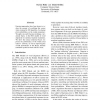103
Voted
ACL
2012
13 years 3 months ago
2012
This paper presents an unsupervised approach to learning translation span alignments from parallel data that improves syntactic rule extraction by deleting spurious word alignment...
133
Voted
ACL
2012
13 years 3 months ago
2012
The dominant practice of statistical machine translation (SMT) uses the same Chinese word segmentation specification in both alignment and translation rule induction steps in buil...
121
Voted
ACL
2012
13 years 3 months ago
2012
Bayesian approaches have been shown to reduce the amount of overfitting that occurs when running the EM algorithm, by placing prior probabilities on the model parameters. We appl...
114
click to vote
ACL
2011
14 years 4 months ago
2011
We cast the word alignment problem as maximizing a submodular function under matroid constraints. Our framework is able to express complex interactions between alignment component...
124
Voted
ACL
2011
14 years 4 months ago
2011
We present an unsupervised model for joint phrase alignment and extraction using nonparametric Bayesian methods and inversion transduction grammars (ITGs). The key contribution is...
127
Voted
ACL
2011
14 years 4 months ago
2011
We propose a language-independent method for the automatic extraction of transliteration pairs from parallel corpora. In contrast to previous work, our method uses no form of supe...
113
Voted
COLING
2010
14 years 7 months ago
2010
While ITG has many desirable properties for word alignment, it still suffers from the limitation of one-to-one matching. While existing approaches relax this limitation using phra...
107
click to vote
COLING
2010
14 years 7 months ago
2010
We employ Maximum Entropy model to conduct sub-tree alignment between bilingual phrasal structure trees. Various lexical and structural knowledge is explored to measure the syntac...
106
Voted
EMNLP
2009
14 years 10 months ago
2009
Statistical bilingual word alignment has been well studied in the context of machine translation. This paper adapts the bilingual word alignment algorithm to monolingual scenario ...
112
Voted
ACL
2009
14 years 10 months ago
2009
In this paper we present a confidence measure for word alignment based on the posterior probability of alignment links. We introduce sentence alignment confidence measure and alig...

